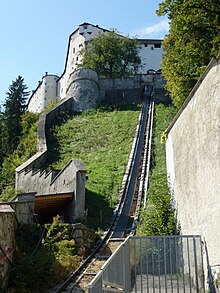Tear pull
The tearing train (also in the writing variant Reiszug ) is a funicular in the Austrian city of Salzburg intended for the transport of materials and leads from the Nonnberg to the Hohensalzburg fortress . It is probably the oldest surviving cable car in the world. Today it is used solely for the transport of goods and is essentially not open to the public. The Salzburg fortress railway is used to transport people to the fortress .
history
Naming
The name of Ages in Central Europe emerged from the Middle High German word Risen - the word today traveling - with the former meaning, moving from bottom to top, rise (cf. Engl.. To rise ); move from top to bottom, fall '. (From Risen is also the word travel in the original meaning, departure, travel, train 'derived.) The term -zug is derived from the verb draw . The word originally referred to a device with which things can be transported from the bottom up and vice versa by pulling. The name for the cable car has therefore - despite certain factual similarities - nothing to do with a train in the current sense of a railway and nothing to do with the term tear . The railway was previously referred to as a “journey” based on rīsen , but the establishment of a connection with a journey in today's sense is to be seen as lay etymology .
Building history
The tearing train leads from the monastery of Nonnberg into the inner area of the fortress and, according to architectural historical findings in the area of the snake passage, goes back at least to the year 1460, and thus the troubled time before the reign of Bernhard von Rohrs . The opinion that the construction under Leonhard von Keutschach was only carried out in 1502 is today largely disproved. A wall train to secure the tear train was built under Burghard von Weißpriach around 1461. In 1515 the draft itself is described in detail in a reliable source. The pulling train was built primarily to transport materials. In winter, the train ran several times a day, because there was usually no other supply option for the castle. Initially, two sledges ran in opposite traffic, a little later rails made of hardwood were laid on which the two carts moving in opposite directions moved. The first documented ripper building with its earlier cable winch for the more than 300 m long hemp rope required for operation was probably built around 1496 under Leonhard von Keutschach. The current pulling train building dates from 1644.
The tear train inevitably broke through the fort's defensive rings and therefore had to be heavily secured itself. The many fortified gate openings have been preserved. The so-called Hell Gate was built in 1504. The ripping tower, which is now integrated into the castle wall, was built above the ripping train. The drawbridge over which the wagons once drove has disappeared, but in an emergency the two bridges of the tear train could be thrown off. The late Gothic cantilever tower to secure the gateway to the Nonnbergbastei was demolished in the 19th century.
Until 1910, this train was driven by a horizontal wooden cable winch with long lever arms with the help of muscle power ( Göpel ), usually from horses that were clamped and moving in a circle. In the beginning and in the 19th century prisoners were also used, whereby at least nine convicts were necessary for the operation. From 1910 onwards, an electric mining winch was used.
From 1881 to 1885 the complex was owned by the k. u. k. Military administration renovated. Three wooden bridges were dismantled and replaced by steel structures on which conventional narrow-gauge railway tracks were relocated. After a renovation in 1950, the rails were converted from narrow gauge to standard gauge in 1951 . Further renovations took place in the years 1988–1990 and 2004. Today, the tear train can also run at night , secured by infrared cameras . The drive and monitoring are carried out from the mountain station. Even today, the pulling train is basically only used to transport material, and authorized persons are only allowed to travel in exceptional cases.
According to the calculations of Clemens M. Hutter, the railway needed about an hour for an ascent in earlier centuries. After the installation of the 38 hp engine in 1910, a trip up the mountain took just under 30 minutes. Today the distance is covered in a good five minutes.
Technical specifications
- Difference in altitude: 80 m
- Route length: 190 m
- Gradient: 67%
- Driving equipment: 1 for 1500 kg payload or 3 people
- Speed: 0.55 m / s
- Travel time: 5.45 min
Individual evidence
- ↑ Etymological dictionary of German , developed under the direction of Wolfgang Pfeifer, 7th edition, dtv, Munich 2004. Duden: The dictionary of origin , 4th edition, Bibliographisches Institut, Mannheim 2007.
- ^ Gunter Mackinger : 120 years of the Salzburg fortress railway. Salzburg 2011, p. 7.
- ↑ Reinhard Kriechbaum: The great journey up the mountain , in the daily mail , May 15, 2004
literature
- Gunter Mackinger : 120 years of the Salzburg Fortress Railway. Chapter 3: Der Reiszug, pp. 6-7, (undated) Salzburg 2011 (brochure without ISBN).
Web links
- The tear train on seilbahngeschichte.de ( Memento from September 28, 2011 in the Internet Archive )




